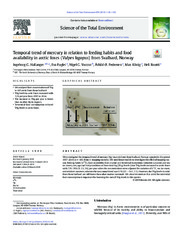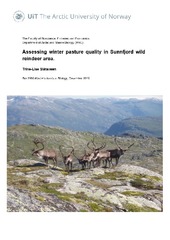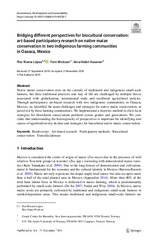Institutt for arktisk og marin biologi: Recent submissions
Now showing items 1121-1140 of 2084
-
Temporal trend of mercury in relation to feeding habits and food availability in arctic foxes (Vulpes lagopus) from Svalbard, Norway
(Journal article; Tidsskriftartikkel; Peer reviewed, 2019-03-20)We investigated the temporal trend of mercury (Hg) in arctic foxes from Svalbard, Norway sampled in the period 1997–2014 (<i>n</i> = 109, from 11 trapping seasons). We used linear models to investigate the effect of trapping season, feeding habits (δ<sup>13</sup>C), food availability from marine and terrestrial ecosystems (reindeer carcasses and sea ice cover), sex, age and body condition on liver ... -
Disappearing green: Shrubs decline and bryophytes increase with nine years of increased snow accumulation in the High Arctic
(Journal article; Tidsskriftartikkel; Peer reviewed, 2019-07-25)<i>Question</i> - How does increased snow depth affect plant community composition of High Arctic tundra, and can the Normalized Differential Vegetation Index (NDVI) detect induced changes?<p><p> <i>Location</i> - Adventdalen, Spitsbergen, Svalbard (78°10′ N, 16°04′ E).<p><p> <i>Methods</i> - We manipulated snow depth on the tundra using fences, resulting in <i>Deep, Medium</i>, and ... -
Feeding studies take guts - critical review and recommendations of methods for stomach contents analysis in fish
(Journal article; Tidsskriftartikkel; Peer reviewed, 2019-10-07)Studies on the feeding ecology of fish are essential for exploring and contrasting trophic interactions and population and community dynamics within and among aquatic ecosystems. In this respect, many different methods have been adopted for the analysis of fish stomach contents. No consensus has, however, been reached for a standardised methodology despite that for several decades there has been an ... -
Selective mineral transport barriers at Cuscuta-host infection sites
(Journal article; Tidsskriftartikkel; Peer reviewed, 2019-10-11)The uptake of inorganic nutrients by rootless parasitic plants, which depend on host connections for all nutrient supplies, is largely uncharted. Using X‐ray fluorescence spectroscopy (XRF), we analyzed the element composition of macro‐ and micronutrients at infection sites of the parasitic angiosperm <i>Cuscuta reflexa</i> growing on hosts of the genus <i>Pelargonium</i>. Imaging methods combining ... -
Environmental filtering and phylogenetic clustering correlate with the distribution patterns of cryptic protist species
(Journal article; Tidsskriftartikkel; Peer reviewed, 2018-01-29)The community composition of any group of organisms should theoretically be determined by a combination of assembly processes including resource partitioning, competition, environmental filtering, and phylogenetic legacy. Environmental DNA studies have revealed a huge diversity of protists in all environments, raising questions about the ecological significance of such diversity and the degree to ... -
Tipping point in plant-fungal interactions under severe drought causes abrupt rise in peatland ecosystem respiration
(Journal article; Tidsskriftartikkel; Peer reviewed, 2017-10-09)Ecosystems are increasingly prone to climate extremes, such as drought, with long‐lasting effects on both plant and soil communities and, subsequently, on carbon (C) cycling. However, recent studies underlined the strong variability in ecosystem's response to droughts, raising the issue of nonlinear responses in plant and soil communities. The conundrum is what causes ecosystems to shift in response ... -
Comparative vegetation survey with focus on cryptogamic covers in the high Arctic along two differing catenas
(Journal article; Tidsskriftartikkel; Peer reviewed, 2019-09-24)Although cryptogamic covers are important ecosystem engineers in high Arctic tundra, they were often neglected in vegetation surveys. Hence we conducted a systematic survey of cryptogamic cover and vascular plant coverage and composition at two representative, but differing Arctic sites (Ny-Ålesund, Svalbard) along catenas with a natural soil moisture gradient, and integrated these data with ... -
Discontinuity in the molecular neuroendocrine response to increasing daylengths in Ile-de-France ewes: Is transient Dio2 induction a key feature of circannual timing?
(Journal article; Tidsskriftartikkel; Peer reviewed, 2019-07-24)In mammals, melatonin is responsible for the synchronisation of seasonal cycles to the solar year. Melatonin is secreted by the pineal gland with a profile reflecting the duration of the night and acts via the pituitary pars tuberalis (PT), which in turn modulates hypothalamic thyroid hormone status via seasonal changes in the production of locally‐acting thyrotrophin. Recently, we demonstrated that, ... -
Assessing winter pasture quality in Sunnfjord wild reindeer area
(Master thesis; Mastergradsoppgave, 2019-11-30)Winter pastures are bottlenecks for population trends for wild reindeer, and the quality and availability are important parameters when managing populations. Sunnfjord, considered on of the smallest wild reindeer districts in Norway, have never had a comprehensive evaluation of accessible winter pasture within. The aim of study is to assess the quality of winter forage in all tree sub- areas within ... -
Relationship between carbon- and oxygen-based primary productivity in the Arctic Ocean, svalbard archipelago
(Journal article; Tidsskriftartikkel; Peer reviewed, 2019-08-02)Phytoplankton contribute half of the primary production (PP) in the biosphere and are the major source of energy for the Arctic Ocean ecosystem. While PP measurements are therefore fundamental to our understanding of marine biogeochemical cycling, the extent to which current methods provide a definitive estimate of this process remains uncertain given differences in their underlying approaches, and ... -
Activity patterns in mammals: Circadian dominance challenged
(Journal article; Tidsskriftartikkel; Peer reviewed, 2019-07-15)The evidence that diel patterns of physiology and behaviour in mammals are governed by circadian ‘clocks’ is based almost entirely on studies of nocturnal rodents. The emergent circadian paradigm, however, neglects the roles of energy metabolism and alimentary function (feeding and digestion) as determinants of activity pattern. The temporal control of activity varies widely across taxa, and ungulates, ... -
Seroprevalence of pestivirus in Eurasian tundra reindeer in Finland, Sweden, Norway, Iceland and Russian Federation
(Journal article; Tidsskriftartikkel; Peer reviewed, 2019-10-29)Reindeer herding is of great importance for the indigenous people of the Fennoscandia peninsula and northern Russia. There are also free-ranging feral populations of reindeer in Finland, Iceland, Norway and Russian Federation. The genus Pestivirus contains several viral species that infect ungulates and often show capacity to transmit between different host species. Sera from 520 Eurasian tundra ... -
Evidence of seawater drinking in fasting subadult hooded seals (Cystophora cristata)
(Journal article; Tidsskriftartikkel; Peer reviewed, 2019-01-29)The purpose of this study was to investigate the total water turnover rate of fasting subadult hooded seals in order to elucidate to what extent these animals rely in seawater drinking/mariposia at this life stage. Considering mariposia is important for later accurate estimations of food consumption using water turnover rate as a proxy. Five subadult hooded seals were kept fasting for 4 days in a ... -
Sinking Organic Particles in the Ocean—Flux Estimates From in situ Optical Devices
(Journal article; Tidsskriftartikkel; Peer reviewed, 2020-02-18)Optical particle measurements are emerging as an important technique for understanding the ocean carbon cycle, including contributions to estimates of their downward flux, which sequesters carbon dioxide (CO<sub>2</sub>) in the deep sea. Optical instruments can be used from ships or installed on autonomous platforms, delivering much greater spatial and temporal coverage of particles in the mesopelagic ... -
Facilitation mediates species presence beyond their environmental optimum
(Journal article; Tidsskriftartikkel; Peer reviewed, 2019-04-01)Species distributions are driven by abiotic conditions that filter species with specific traits and physiological tolerances and match them with their suitable environment. Plant–plant interactions can constrict (through competition) or loosen (through facilitation) the strength of these environmental filters, which in turn inhibit or enhance establishment and recruitment of plant species at a finer ... -
Behavior and thermal environment of Chinook salmon Oncorhynchus tshawytscha in the North Pacific Ocean, elucidated from pop-up satellite archival tags
(Journal article; Tidsskriftartikkel; Peer reviewed, 2019-06-22)Chinook salmon are widely distributed in offshore waters of the North Pacific Ocean, and of great economical and subsistence importance; however, little is known about their oceanic ecology. To address this, we tagged 43 Chinook salmon <i>Oncorhynchus tshawytscha</i> (57–100 cm) with pop-up satellite archival tags (PSATs) in the eastern (October– December) and central Bering Sea (August) to provide ... -
Bridging different perspectives for biocultural conservation: art-based participatory research on native maize conservation in two indigenous farming communities in Oaxaca, Mexico
(Journal article; Tidsskriftartikkel; Peer reviewed, 2019-12-21)Native maize conservation rests on the custody of traditional and indigenous small-scale farmers, but their traditional practices and way of life are challenged by multiple forces associated with globalization, international trade and neoliberal agricultural policies. Through participatory art-based research with two indigenous communities in Oaxaca, Mexico, we identified the main challenges and ... -
Contrasting changes in space use induced by climate change in two Arctic marine mammal species
(Journal article; Tidsskriftartikkel; Peer reviewed, 2019-03-06)Global warming is inducing major environmental changes in the Arctic. These changes will differentially affect species owing to differences in climate sensitivity and behavioural plasticity. Arctic endemic marine mammals are expected to be impacted significantly by ongoing changes in their key habitats owing to their long life cycles and dependence on ice. Herein, unique biotelemetry datasets for ... -
Marine trophic niche-use and life history diversity among Arctic charr Salvelinus alpinus in southwestern Greenland
(Journal article; Tidsskriftartikkel; Peer reviewed, 2020-01-22)Life history strategies and potential marine niche use of Arctic charr <i>Salvelinus alpinus</i> (<i>n</i> = 237, 84–652 mm, total body length, <i>L<sub>T</sub></i>) were determined during the ice‐free season (2012) at three different watercourses in south‐western Greenland. All Arctic charr were collected from freshwater habitats. Based on stable isotopes of δ<sup>34</sup>S, the Arctic charr were ... -
Introduction of Mysis relicta (Mysida) reduces niche segregation between deep-water Arctic charr morphs
(Journal article; Tidsskriftartikkel; Peer reviewed, 2019-04-26)Niche diversification of polymorphic Arctic charr can be altered by multiple anthropogenic stressors. The opossum-shrimp (<i>Mysis relicta</i>) was introduced to compensate for reduced food resources for fish following hydropower operations in Lake Limingen, central Norway. Based on habitat use, stomach contents, stable isotopes (δ<sup>13</sup>C, δ<sup>15</sup>N) and trophically transmitted parasites, ...


 English
English norsk
norsk


















